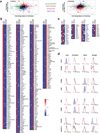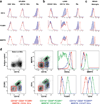Gene-expression profiles and transcriptional regulatory pathways that underlie the identity and diversity of mouse tissue macrophages
- PMID: 23023392
- PMCID: PMC3558276
- DOI: 10.1038/ni.2419
Gene-expression profiles and transcriptional regulatory pathways that underlie the identity and diversity of mouse tissue macrophages
Abstract
We assessed gene expression in tissue macrophages from various mouse organs. The diversity in gene expression among different populations of macrophages was considerable. Only a few hundred mRNA transcripts were selectively expressed by macrophages rather than dendritic cells, and many of these were not present in all macrophages. Nonetheless, well-characterized surface markers, including MerTK and FcγR1 (CD64), along with a cluster of previously unidentified transcripts, were distinctly and universally associated with mature tissue macrophages. TCEF3, C/EBP-α, Bach1 and CREG-1 were among the transcriptional regulators predicted to regulate these core macrophage-associated genes. The mRNA encoding other transcription factors, such as Gata6, was associated with single macrophage populations. We further identified how these transcripts and the proteins they encode facilitated distinguishing macrophages from dendritic cells.
Conflict of interest statement
Figures





Similar articles
-
Network analysis of transcriptomic diversity amongst resident tissue macrophages and dendritic cells in the mouse mononuclear phagocyte system.PLoS Biol. 2020 Oct 8;18(10):e3000859. doi: 10.1371/journal.pbio.3000859. eCollection 2020 Oct. PLoS Biol. 2020. PMID: 33031383 Free PMC article.
-
Novel regulators of the systemic response to lipopolysaccharide.Am J Respir Cell Mol Biol. 2011 Aug;45(2):393-402. doi: 10.1165/rcmb.2010-0342OC. Epub 2010 Dec 3. Am J Respir Cell Mol Biol. 2011. PMID: 21131441 Free PMC article.
-
Extensive repertoire of membrane-bound and soluble dendritic cell-specific ICAM-3-grabbing nonintegrin 1 (DC-SIGN1) and DC-SIGN2 isoforms. Inter-individual variation in expression of DC-SIGN transcripts.J Biol Chem. 2001 Aug 31;276(35):33196-212. doi: 10.1074/jbc.M009807200. Epub 2001 May 3. J Biol Chem. 2001. PMID: 11337487
-
Transcriptional repression shapes the identity and function of tissue macrophages.FEBS Open Bio. 2021 Dec;11(12):3218-3229. doi: 10.1002/2211-5463.13269. Epub 2021 Aug 14. FEBS Open Bio. 2021. PMID: 34358410 Free PMC article. Review.
-
Studying the mononuclear phagocyte system in the molecular age.Nat Rev Immunol. 2011 Oct 25;11(11):788-98. doi: 10.1038/nri3087. Nat Rev Immunol. 2011. PMID: 22025056 Review.
Cited by
-
The pathogenic role of angiogenesis in rheumatoid arthritis.Angiogenesis. 2015 Oct;18(4):433-48. doi: 10.1007/s10456-015-9477-2. Epub 2015 Jul 22. Angiogenesis. 2015. PMID: 26198292 Free PMC article. Review.
-
Redefining the transcriptional regulatory dynamics of classically and alternatively activated macrophages by deepCAGE transcriptomics.Nucleic Acids Res. 2015 Aug 18;43(14):6969-82. doi: 10.1093/nar/gkv646. Epub 2015 Jun 27. Nucleic Acids Res. 2015. PMID: 26117544 Free PMC article.
-
Autophagic adaptation to oxidative stress alters peritoneal residential macrophage survival and ovarian cancer metastasis.JCI Insight. 2020 Sep 17;5(18):e141115. doi: 10.1172/jci.insight.141115. JCI Insight. 2020. PMID: 32780724 Free PMC article.
-
Improved Angiogenesis in Response to Localized Delivery of Macrophage-Recruiting Molecules.PLoS One. 2015 Jul 1;10(7):e0131643. doi: 10.1371/journal.pone.0131643. eCollection 2015. PLoS One. 2015. PMID: 26132702 Free PMC article.
-
Proteomic Analysis Reveals Distinct Metabolic Differences Between Granulocyte-Macrophage Colony Stimulating Factor (GM-CSF) and Macrophage Colony Stimulating Factor (M-CSF) Grown Macrophages Derived from Murine Bone Marrow Cells.Mol Cell Proteomics. 2015 Oct;14(10):2722-32. doi: 10.1074/mcp.M115.048744. Epub 2015 Jul 30. Mol Cell Proteomics. 2015. PMID: 26229149 Free PMC article.
References
-
- Heng TS, Painter MW. The Immunological Genome Project: networks of gene expression in immune cells. Nat Immunol. 2008;9:1091–1094. - PubMed
-
- Gordon S, Taylor PR. Monocyte and macrophage heterogeneity. Nat Rev Immunol. 2005;5:953–964. - PubMed
-
- Hume DA. Differentiation and heterogeneity in the mononuclear phagocyte system. Mucosal Immunol. 2008;1:432–441. - PubMed
Publication types
MeSH terms
Substances
Associated data
- Actions
Grants and funding
- 5T32DA007135-27/DA/NIDA NIH HHS/United States
- P50 GM071558/GM/NIGMS NIH HHS/United States
- R01 CA154947/CA/NCI NIH HHS/United States
- T32 DA007135/DA/NIDA NIH HHS/United States
- R01 AI061741/AI/NIAID NIH HHS/United States
- R01 AI049653/AI/NIAID NIH HHS/United States
- R01 GM098316/GM/NIGMS NIH HHS/United States
- P30 DK020579/DK/NIDDK NIH HHS/United States
- P50GM071558-03/GM/NIGMS NIH HHS/United States
- R01AI049653/AI/NIAID NIH HHS/United States
- R01AI061741/AI/NIAID NIH HHS/United States
- R01DK08854/DK/NIDDK NIH HHS/United States
- R24 AI072073/AI/NIAID NIH HHS/United States
- R01 AI046553/AI/NIAID NIH HHS/United States
LinkOut - more resources
Full Text Sources
Other Literature Sources
Molecular Biology Databases
Research Materials
Miscellaneous

